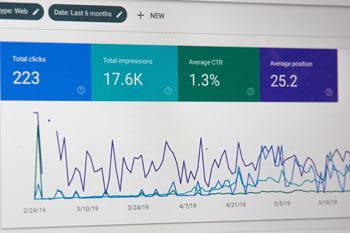Website traffic is a major factor in the success of any online business, and knowing when your website's traffic is at its highest can help you optimize your website for better results. Traffic peaks may be universal but visitor experiences may vary from country to country, so tracking these fluctuations can be essential for any website owner looking to maximise the effect of the traffic.
How Do You Measure Your Website Traffic?
Website traffic is the number of visitors that visit a website during a specific time period. Website traffic can be measured in different ways, but one method is to use Google Analytics. Traffic can be estimated further by looking at search engine traffic, social media traffic and email traffic.
Understanding website traffic can help you to understand how your website is performing and to plan for future growth. Knowing when your website traffic peak hours are can help you to plan your campaign strategy for better performance during these times.

Internet Rush Hour
According to the studies conducted in the past decade, the internet rush hours are between 9 am and midday, as well as between 7 and 11 pm. Users generally experience slow browsing and downloading during these peak hours, as demand for resources exceeds capacity. On the other hand, 4 am is considered to be the quietest time on the internet.
But all this only applies if the majority of your target audience is in one country. If your audience is spread across the globe, the peak hours mean very little.
Website traffic peak hours are considered to be between 9 am and midday, and between 7 pm and 11 pm. It's only useful to know if you are geotargeting your audience in a single country.
What Causes Website Peak Hours?
You can think of how peak hours and off-peak hours are created during the day.
- In the morning: The first thing a lot of people do when they wake up in the morning is to pick up their smartphone and catch up with their social media followers. Or while getting ready for the day, people check the news, weather, etc. At home, or while commuting.
- In the afternoon: Teenagers are out of school, working on their assignments, and looking for entertainment. Adults are also online more in the afternoon.
- At night: People are winding down for the day and spending long hours watching streaming services such as Netflix, or looking for other entertainment. Or searching for any information - for study and business purposes.
When Are Website Traffic Peak Days Of The Week?

Traffic peaks can occur on certain days of the week, and knowing when these days are can help you optimise your website for maximum viewership. Traffic peaks can also be helpful in understanding which areas of your website are performing well and which need improvement.
The following are five common traffic peak days of the week:
- Monday: Web traffic typically peaks on Mondays due to the fact that people are starting to get back to work and have more time on their hands to visit websites.
- Tuesday: Tuesday is often considered a medium-traffic day, with around 30-40% of all web traffic occurring on this day.
- Wednesday: Wednesday is usually considered a high-traffic day, with around 50-60% of all web traffic occurring on this day.
- Thursday: Thursday is typically considered a low-traffic day, with around 10-20% of all web traffic occurring on this day.
- Friday: Friday is generally considered a low-traffic day, with around 5-10% of all web traffic occurring on this day.
By understanding which days of the week tend to generate the most visits, you can create more effective marketing campaigns and strategies that will drive more people to your website.
For example, if you know that Mondays are generally high-traffic days for your website, try running promotional campaigns or sales events on Thursdays or Fridays instead. By doing this, you’ll be sure to optimise your efforts for the highest possible return on investment.
Use Traffic Generation Tools Wisely
It’s a good idea to enable and use traffic generation tools wisely.
Email Autoresponder
One example is autoresponder. Emails that arrive during the night or during working hours can be ignored. Whereas emails that arrive “in your face” while browsing tends to be opened and clicked. So it’s good to set an autoresponder to be sent during the peak hours.
Luckily, many email marketing service providers allow you to set the local time of each subscriber.
Social Post Scheduler
Many social post schedulers suggest the most optimal times to send your posts. However, their suggested times aren’t set according to website traffic peak hours or off-peak hours. They are often set according to the pattern of your other posts (e.g. X hours after your previous post).
You can do your own split test and find out what hours get the most clicks, then stick to those hours, to maximise the number of visitors to your website.
These tools will help you determine which hours are your own potential peak hours, and generate additional income from your website.
Determine Your Own Peak Website Traffic Hours

In order to have an effective website, it is important to know when traffic is at its peak. Traffic peaks can be determined by analysing your website’s traffic data over a long period of time. Here are a couple of ways to determine your website’s traffic peak hours.
- Look at your traffic data over a thirty-day period. This gives you a good snapshot of how your website is performing or not performing during which hours respectively over time.
- Look at your traffic data during specific times of the day or week. For example, you could look at your traffic data on Monday mornings from 7 am to 9 am. This approach has the advantage of being more accurate because it reflects the actual behaviour of your website’s visitors.
It can be difficult to track changes over time; the traffic data may not be representative of all website visitors, and the results may not be accurate, but you’ll get better ideas.
Number of Website Visitors During Public Holidays
According to a study by Socialbakers, website traffic is up on public holidays across the world. In fact, during Black Friday and Cyber Monday in the U.S., website traffic was up 25% and 50%, respectively.
What's more, holiday-related website traffic is not confined to one time of year. According to SimilarWeb, November and December are the strongest months for holiday website traffic.
The good news is that even if your website isn't as popular as it used to be, it can still do well during public holidays. If your web hosting company can temporarily increase the capacity for you for an extra cost, it may be worth considering during Thanksgiving and Christmas - two of the best times of the year. This is because visitors tend to hit your site harder than normal during these times due to higher demand from search engines.
Website Traffic Peak Hours - How Accurate Are The Study Results?
After you’ve seen all this information, how much of it would you believe? The truth is, it is important to note that these studies are limited in scope and do not represent the entire world. If your website traffic is down during these times, there may be other reasons such as increased competition from other websites or less interest in the topic.
It is also worth noting that whatever the study results, they only looked at websites with a commercial focus, so it is possible that websites with a more charitable or informative focus would see different results.
Don’t Be Distracted

Too often we get so caught up in our website's traffic statistics that we neglect to focus on the things that will keep our visitors coming back.
Your website is always online and accessible to visitors, no matter where they are. This means that you can engage with them on a personal level, learn what interests them, and keep them coming back for more. You don't have to miss out on any potential traffic just because you are not analysing your website traffic during peak hours.
Focus on building and maintaining a good website instead. This means;
- Your website looks good and functions properly on all devices.
- The site loading time is optimised for all devices.
- You are providing valuable content.
- You are developing engaging features.
- The content is staying up to date with web trends.
These are all key ingredients for keeping your website a top destination. Visitors want an easy experience when visiting your site. Keep in mind that engaging with visitors is key to keeping them coming back. Share interesting content on your site, answer questions, and provide valuable resources. Make it as easy as possible for people to find what they're looking for, and you'll be well on your way to building a successful website.
Website traffic peak hours? Who cares?
What Do You Advocate?
